
|
Back |
Bermuda
May 1-8, 2004 |
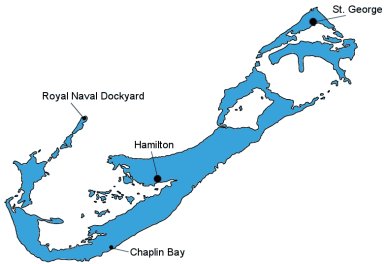
|
|
|
|
The island nation of Bermuda (actually some 350 islands
altogether) lies 650 miles east of North Carolina. Formed
by the cone of an extinct underwater volcano, the islands
jut out of the Atlantic in the shape of a fish hook about
20 miles long and 2 miles wide. Despite a few visitors (such
as the Spaniard Juan de Bermúdez in 1503 for whom
the islands are named), Bermuda remained uninhabited largely
because of the encircling coral reefs that have claimed
over 30 ships since 1563. It was the wreck of the Sea
Venture on the shoals in 1609 while en route to re-supply
the fledgling Jamestown colony in Virginia that first brought
colonists to Bermuda.
A year later, the stranded colonists set sail from Bermuda
in two ships constructed mainly from the remains of the
Sea Venture; however, the Virginia Company would
amend its charter to include Bermuda and sent 60 new settlers
to create a permanent colony. The new colonists founded
the town of St. George not far from where survivors of the
Sea Venture first came ashore, making Bermuda Britain’s
oldest successful colony. Bermuda was subsequently divided
up into nine parishes, the first called St. George and the
remainder named for each of the eight investors responsible
for sending the colonists.
Bermuda played a pivotal roll as a trading center for Confederate
goods during the US Civil War, allowing the South to generate
revenue to buy much-needed arms. At the height of the war,
a Confederate doctor came to Bermuda ostensibly to help
with an outbreak of yellow fever. In reality, he was executing
a plan to gather blankets from the diseased patients and
send them stateside in the hope of spreading the epidemic
to the Yankees. World War II also saw a flurry of activity
as Bermuda was used as a hub to monitor transatlantic communications
for coded messages as well as housing a US military base
and a key port for the Royal Navy.
With no exportable natural resources, Bermuda relies primarily
on tourism for revenue. The capital in Hamilton is home
to the oldest parliament outside of Britain as well as the
Queen-appointed governor, continuing its tradition as a
British colony. Four hundred years of British affiliation
and the introduction of slavery soon after colonization
have resulted in a multiracial nation of approximately 60,000
inhabitants.
|
|
|
|
We took the train early to meet up with D’s parents at
their hotel in Boston. A quick and harrowing cab ride to
the Black Falcon Terminal, and we were all set to board
the Norwegian Majesty. Heightened security dictated
that we wait in line for a good long time, but we made the
best of it by chatting up some of our shipmates. The crowd
was a mixture of the geriatric crowd and thirty-somethings
who either had no kids or ones too young for school. Security
was pretty tight as all checked bags were being x-rayed,
though the only thing being confiscated seemed to be liquor.
Finally passing through customs, we made our way onto the
ship.
D’s parents had a stateroom topside with a wonderful view
of a lifeboat. We, on the other hand, had opted for the
more wallet-friendly bowels of the ship. In the end, things
turned out well - the tiny cabin was cozy, and we had no
neighbors.
Back up on deck, we watched as our bags, piled ten deep
in large bins, were heaved on board. Finally, the engines
were fired up, and we slowly pulled away from the Hub. Our
expectations of a Love Boat-style bon voyage were
left wanting as only a handful of Port Authority officials
and Russian cab drivers waved as we motored out of sight.
|
|
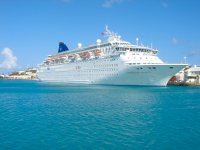
The Norwegian Majesty
in all its glory.
|
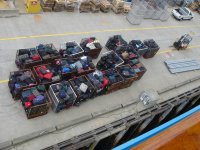
Our bags must
have been on the bottom.
| 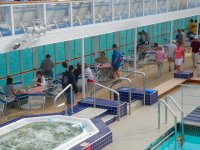
Dining al fresco
on deck.
|
|
|
|
Not surprisingly, this was our first
time on a cruise ship. Thus, our first day was at sea was
spent exploring the ship and all of its offerings. Since
it was a little too windy and brisk for the outdoor track,
we chose to make use of the well-stocked fitness center
near our cabin. Running on a treadmill is quite challenging
on a moving ship.
Norwegian offers a number of dining options. They subscribe
to the “free-style” dining format, so passengers can either
sample either the restaurants or the buffet lines with both
being included in the cost of the cruise. Not unexpectedly,
the food in the restaurants is far superior to that of the
buffet lines; however, the convenience and flexibility of
the buffet it an ideal choice for breakfast and lunch. Dinner,
on the other hand, is best had at one of three restaurants
(two seatings per night) where one can choose from Italian
fare, seafood, steak, etc. The gourmet meals were really
top-notch.
Each day provided a new selection of programs ranging from
art auctions, gaming lessons, and aerobics to dancing, karaoke,
and children’s activities. Seizing the opportunity to relax
in the sun and read, we decided to forgo all of the events.
One that did look tempting was Beginning Romanian (a significant
number of boat staff were Romanian).
|
|
|
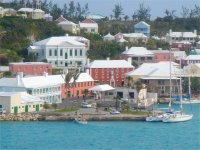
Cruising into St.
George.
|
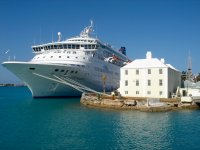
Our port of call
for the week.
| 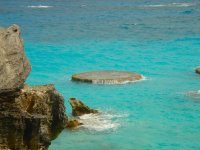
Cool rock formation.
|
|
|
Just after breakfast, we sighted
land in the distance. There was a buzz all through the boat
as people prepared for our eventual arrival. It took another
couple hours to actually roll through the narrow inlet leading
to the port of St. George. Being one of the first boats
of the season, a number of locals lined the inlet cheering
and welcoming us to the island. They even fired off the
cannon at Gates Fort to signal our arrival.
Leading up to our trip, we had been
studying the current and historical weather patterns of
Bermuda to figure out whether we were going to have sun
or rain. For this second week of May, things did not look
promising. Still, as we pushed into the harbor, the sun
shone high in the sky and not a cloud was in sight. Thinking
that the vast majority of passengers would spend the afternoon
getting acquainted with St. George, we decided right then
and there to head straight for the beach. D had researched
some secluded spots such as Water Rocks, Astwood Cove, and
Jobson’s Cove, but we found that there were hardly any beach
dwellers this early in the season, so we had our pick.
We ended up on a sprawling beach
guarded by cliffs on either side near Chaplin Bay. Tiny
bits of red coral wash up on shore and mix with the sand
to give beaches in this part of Bermuda their unique pink
hue. The water itself was crystal clear and looked very
inviting, but it was still a little chilly that time of
year. Littered along the beach were purple-tentacled, bloated
Portuguese man-of-wars waiting for the tide to rescue them
back into the ocean. During the course of the day, we didn't
see any jellyfish in the water, but you always had it in
the back of your mind. The last thing you want to do is
run into one of those guys unexpectedly. Jellyfish stings
and sunburn are a lethal combination.
|
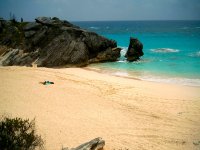
Our secluded
beach at Chaplin's Bay (except for the peeper on the ridge).
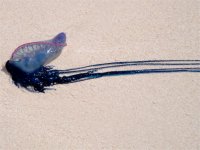
A Portuguese
man-of-war washed up on shore.
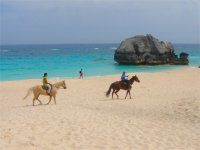
Still to cold
for most swimmers, horseback riding is a popular alternative
beach activity.
|
|
|
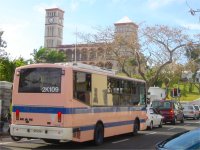
A city bus rolls
by the Sessions House in Hamilton - home of the Supreme
Court.
|
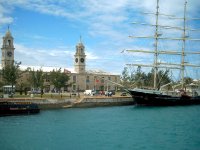
A view of the
Royal Naval Dockyards.
| 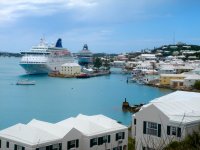
Leaving St. George.
|
|
|
High-fives were in order. Passengers
dressed in their beach clothes gazed out the ships windows
at the torrential downpour that had began early that morning
and was not to let up until mid-afternoon. Having gotten
enough sun to last the whole week (D was already his usual
“vacation red”), we planned on spending some quality time
with D’s parents. We had all purchased three-day bus passes
from the tourist bureau in St. George. We thought this was
a good move since it gave us unlimited bus and ferry use
and we didn’t need to worry about having exact change bus
fare (drivers don’t make change). In the end we probably
broke even but still under-utilized the passes.
The buses are clean, comfortable,
and perfect for a rainy-day excursion. We continued along
the southern road by Tucker’s Town and the southern coast
to Hamilton. Home to around 2,000 inhabitants as well as
the island’s government, Hamilton is rife with restaurants
and shopping, making it the most lively of Bermuda’s cities.
As Bermudians of British, African, and Portuguese descent
mingle with tourists along Front Street, it is a true spectacle
to see the businessmen in their coats, ties, and Bermuda
shorts.
Having caught another bus, we wound along the pink beaches
of the southern coast and up the western part of the Bermuda
comprising the island’s hook. A highlight of the trip was
crossing over Somerset Bridge, a 30 inch drawbridge that
is just wide enough for boats mast. Our destination was
the Royal Naval Dockyards, built in the early 19th century
and intended to be the principal British Naval base in the
Atlantic. Today, however, it houses a variety of shops,
restaurants, and museums. Between visits to the glass blowers
rum cake factory, D and his father sampled some of the local
refreshments and a bowl of Bermuda onion soup at the Frog
& Onion Pub.
|
|
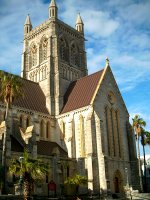
Hamilton's Church
of the Most Holy Trinity or Bermuda Cathedral.
|
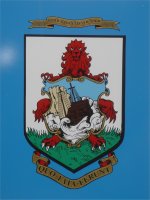
Bermudian coat
of arms showing the Sea Venture sinking in 1609.
| 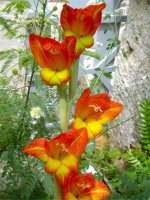
Some of Bermuda's
tropical flora.
|
|
|
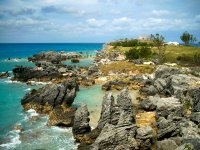
A view of Fort St.
Catherine.
|
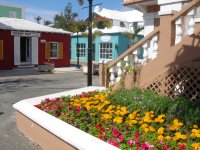
King's Square
in St. George.
| 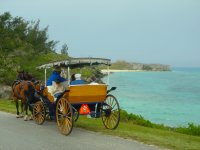
A carriage ride
to Fort St. Catherine.
|
|
|
Our second day in Bermuda, and it was raining again. It
was our last full day in on the islands and we planned to
spend it in St. George. Now a UNESCO World Heritage site,
the town of St. George was the first established on the
island and served as the seat of the government until it
was moved to Hamilton in 1815. A thorough tour of St. George
doesn’t take more than an hour, but there are several nearby
fortifications and beaches that can be included in a more
substantial hike. At the port is a replica of the Deliverance,
the ship constructed from the remains of the Sea Venture
and used by Sir George Somers to continue to Jamestown.
Beginning in King’s Square we headed up through the drizzle
to the Unfinished Church, so called because its construction
was abandoned after 29 years because the funding dried up.
Pushing on to the northern side of the island, we approached
Tobacco Bay, a shallow inlet popular with snorkelers. Even
on this rainy day, the place was crawling with tourists.
Swinging past the manicured St. George Country Club golf
course, we arrived at Fort St. Catherine. This site has
hosted some form of fortification since the very beginning,
from a wooden tower constructed in 1613 to the present concrete
citadel finished in 1865. Adjacent to the fort is St. Catherine’s
Beach where the Sea Venture's survivors first came
ashore.
Circling back around the peninsula, we happened upon an
old Royal Naval cemetery. We took a few minutes in the drizzle
to examine a few of the headstones, most standing for men
who died during a yellow fever outbreak during the mid-1800s.
Soon we passed some small farms before making our way to
an old battery built during the US Civil War. Further on,
we came to Gates Fort which guards the mouth of the harbor.
In its 400 year history, Bermuda has seen the construction
of over 50 fortifications to ensure its protection. Ironically,
only a single shot was ever fired. As the story goes, the
cannon fire successfully warded off a Spanish galleon attempting
to approach the island, which was fortunate since the battery
was equipped with only three cannonballs. Moving on, we
once again encountered the pastel homes that marked the
outskirts of St. George.
|
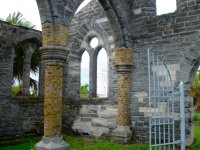
The Unfinished
Church in St. George.
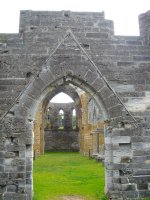
The Unfinished
Church.
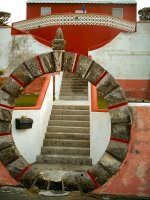
Legend suggests
that stepping through a moongate brings good luck.
|
|
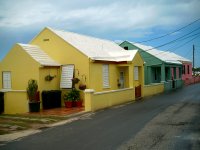
Typical pastel cottages
in St. George.
|
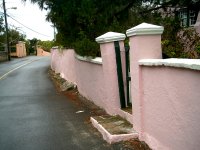
Good contractors
are hard to find.
| 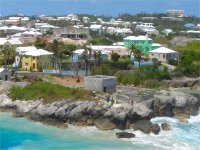
Gates Fort guarded
the entrance to St. George.
|
|
|
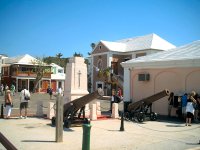
A view of King's
Square in St. George.
|
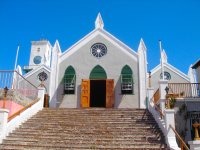
St. Peter's
Church - the oldest continually used Anglican church in
the Western hemisphere.
| 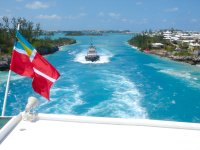
Navigating the
narrow channel leading out of St. George's Harbor.
|
|
|
Our last day began with brilliant sunshine. Knowing the
ship was to sail in 3 hours, our options were limited. D’s
mother and J went on a glass bottom boat tour of the reef.
The seas were a little choppy which resulted in poor water
clarity, but they managed to see a few fish. Meanwhile,
D and his father went for a walk around St. George for one
last look at the beautiful pastel buildings with “wedding
cake” roofs. Not long after they ended up drinking dark
‘n’ stormys in Freddie’s Pub on the Square. They moved on
to the White Horse Tavern to wait for the ladies to return.
Once safely back on shore, J did some last minute shopping
for some tanzanite jewelry. Shortly after noon, we were
homeward bound.
Later that night was the event for which J had been waiting
from the beginning – the notorious midnight chocolate buffet.
We ate early dinners and took naps so that we were in peak
form. It was everything we expected. There were several
large buffet tables replete with chocolate cakes and candies,
chocolate covered fruit of all kinds, chocolate cookies
and brownies, sundaes with chocolate sauce, and of course
just plain chocolate. While D was disgusted with himself
after eating a few pieces of the ultra-rich delicacies,
J went back for thirds.
|
|
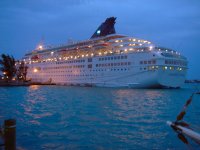
The Majesty at night.
|
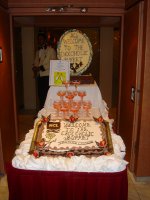
The long-awaited
chocolate buffet.
| 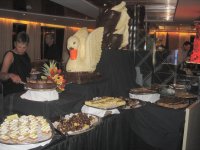
Caloric bombs on
display at the chocolate buffet.
|
|
|
|
Back in open water, the waves were considerably choppier
than during the trip to the island. Seasickness became a popular
malady. It seemed like everyone was on seasickness pills,
wearing patches, or sporting wristbands. Both D’s mother
and J were feeling green, so the day was passed by dining,
drinking, chatting, reading, and napping. It was a good
opportunity to wind down and get ready for the reality of
home. We arrived back in Boston at the crack of dawn Sunday
morning and disembarked by 7am.
|
|
Copyright © 2005 JnDsTravelog.com. All rights reserved. |
|